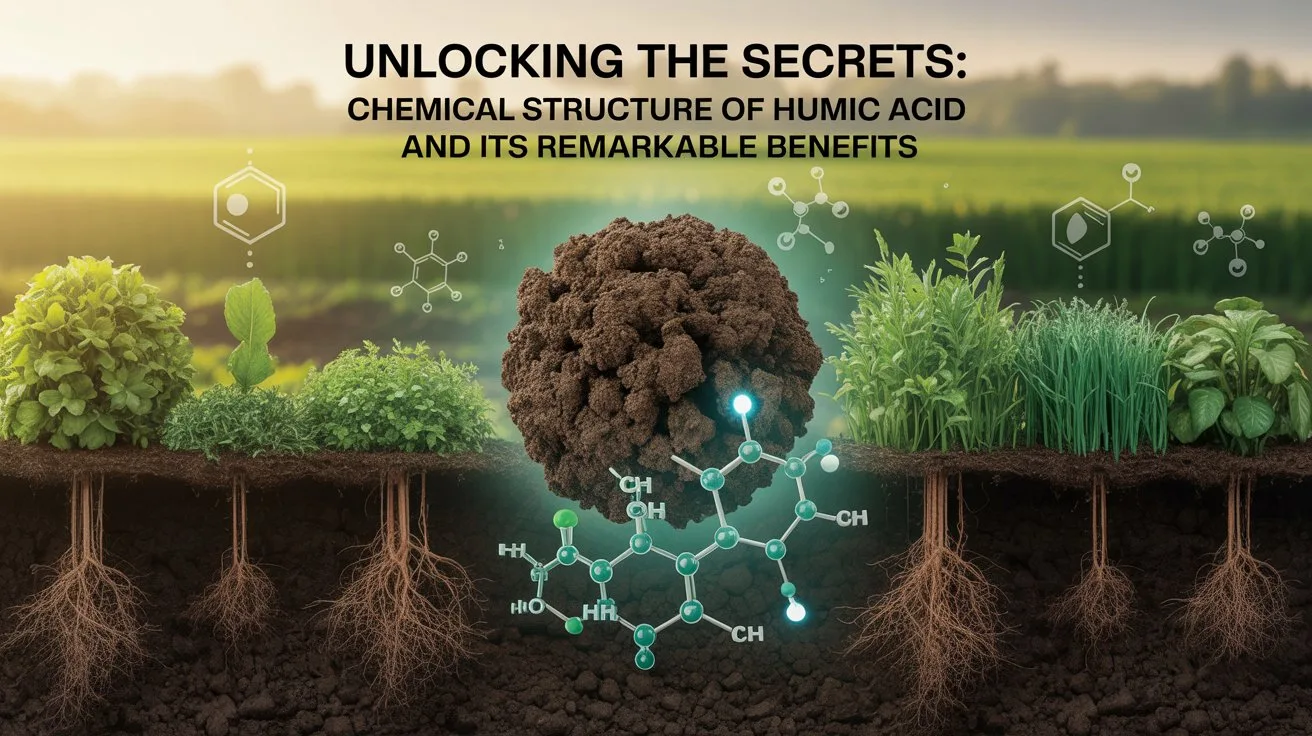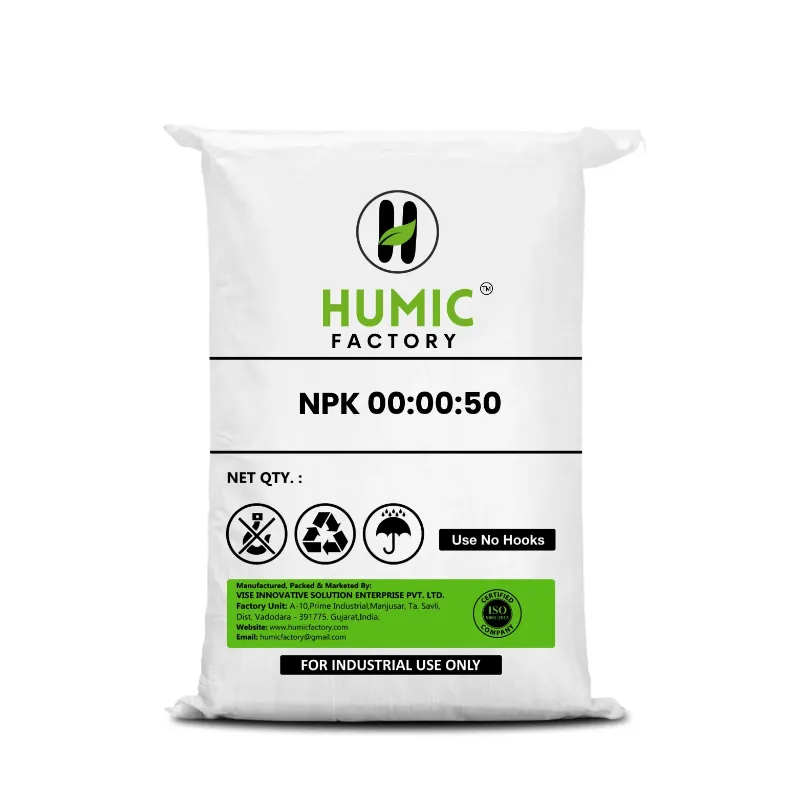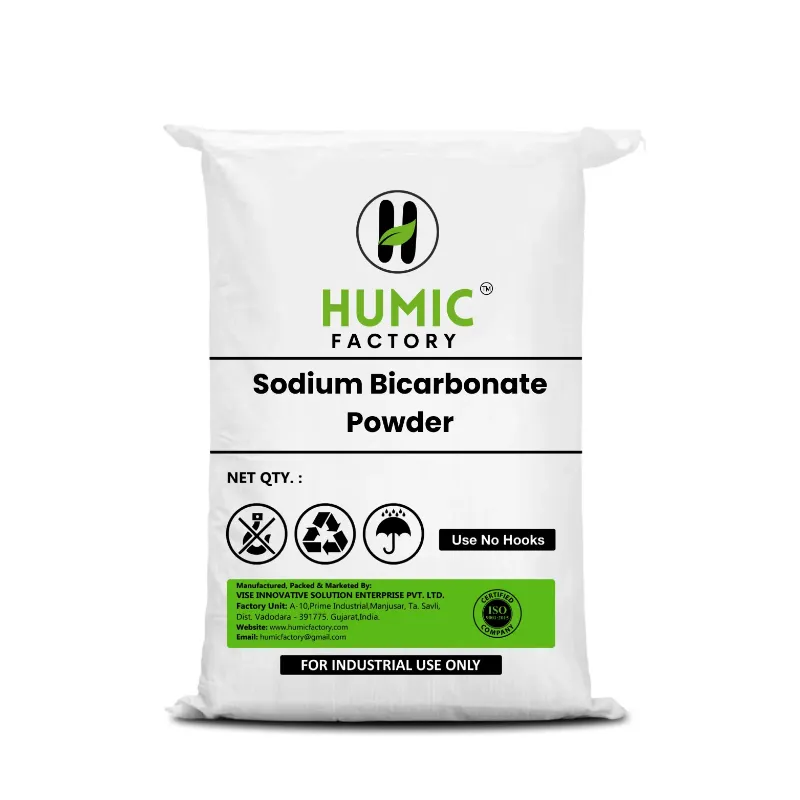Humic acid also has a structure as a chemical, and humic acid is a complex meshwork of organic molecules formed through the weathering of plant and microbial products in the soil. The chemical structure of humic acid is important because it plays a role in ways they influence soil health, nutrient uptake, and plant growth.
Humic acid chemical structure has a very large and complex structure made up of a somewhat irregular, large network of carbon-rich rings and side chains that also include functional groups such as carboxylic acids, phenolic hydroxyls, and ketones. These functional groups enable humic acid molecules to bind with important plant nutrients (calcium, magnesium, iron) and hold them available to the plant over time.
The chemical structure of humic acid also includes both aromatic (ring-like) and aliphatic (chain-like) substances that gives humic acids a relatively balanced water solubility, stability and chemical composition. It is the combination form of solubility, stability and chemical structure enables humic acid to improve soil structure and increase moisture retention capacity, especially in dry or sandy soil.
Another remarkable benefit of humic acids is its ability to stimulate soil microbes. The chemical structure of humic acids supports communities of beneficial soil microorganisms providing alternative sources of energy coupled with better access to nutrients creating a relatively healthy rhizosphere.
Introduction: Why Understanding the Chemical Structure of Humic Acid is Crucial for Innovation
The molecular structure of humic acid explains its positive effect on plant growth and soil improvement. By understanding the molecular structure of humic acid, farmers and researchers can gain an understanding of how it helps retain nutrients, improves water holding capacity, and provides an environment that nurtures beneficial microbial life. Knowledge of the molecular structure aids in understanding the effects of humic acid as farmers explore the use of humic acid as a soil conditioner in many different approaches to agriculture—from traditional farming to the most contemporary organic methods.
Why Farmers and Scientists Study Humic Acid
Both farmers and scientists are interested in the humic acid chemical structure due to its multifunctionality in the improvement of soils. Humic acid is composed of large complex organic molecules. The chemical structure of humic acid allows it to chelate nutrients in ways that other organic fertilizers are unable to do--making nutrients available to the plant.
- Nutrient Interactions: Humic acid will chelate with micronutrients such as zinc and iron, which prevents leaching and provides slow release.
- Soil conditioning: Humic acid's structure improves soil aeration, which is important for root growth and taking in oxygen.
- Microbial stimulation: Humic acid is composed of a variety of molecules and encourages microbial diversity which helps where organic material is degraded into plant available forms.
Linking Humic Chemistry to Soil Performance
The humic acid structure is composed of functional groups—like carboxyl and phenolic groups—that are reactive and influence soil behavior.
These groups allow humic acid to interact dynamically with soil particles and nutrients, influencing everything from pH buffering to enhancing cation exchange capacity (CEC)—critical for fertile soil.
Humic Acid’s Role in Agricultural Innovation
The knowledge about the chemical structure of humic acid has opened the doors to innovation in the agricultural industry in product formulation and sustainable management.
- Product Formulation of Precision Fertilizers: With knowledge of humic chemistry, companies can produce liquid and granular blends that fit the crop and soil type for precision approach to fertilizer.
- Climate Resiliency in Agriculture: Humic acid enhances the ability of plants to survive drought like conditions by its moisture holding capacity, allowing farmers to use a natural product to adapt to climate change.
- Carbon Sequestration: Given the organic structure of humic acid, it plays an important role in stabilizing carbon storage in soils and reducing greenhouse gas emissions.
In summary, the molecular design of humic acid is more than a scientific details, it is a platform for the forthcoming generations of sustainable agriculture.
The Complex Chemistry Behind Humic Acid: An Exploration of Its Molecular Makeup
Humic acid's chemical structure is incredibly complex because it is made up of huge heterogenous molecular components of plant and microbial decomposed material. Humic acid is not one compound but rather a mixture of many heterogenous large molecules that contain rings of aromatics, aliphatic chains, and several functional groups, such as carboxyl, hydroxyl, and phenols. The prominent amounts of rings of aromatics, aliphatic chains, and the groups above lead to its color, i.e., brown and/or black, molecular weight, and reactivity in soil systems.
Humic acid's colloidal nature forms bonds with nutrients and heavy metals affecting the availability and mobility in soils. Due to the flexibility of the molecules, it also contributes to improved soil structure, nutrient holding capacity, and microbial activity.
Understanding Humic Acid Structure Through Organic Chemistry
From an organic chemistry standpoint, the humic acid chemical structure is polyelectrolyte in nature, due to the many acidic functional groups. Some examples include:
- Carboxyl groups (−COOH), which contribute to cation exchange capacity
- Phenolic hydroxyls (−OH), which contribute to antioxidant properties
- Quniones and ketones, which contribute to redox behavior in soil
Such functional groups provide humic acid with different roles in the decomposition of organic matter plus the cycling of nutrients. The breadth in terms of chemical groups allows humic acids to respond and engage with different soil environmental conditions, plus with different levels of stability and bioactivity.
Role of Aromatic and Aliphatic Components in Humic Acids
The humic acid structure contains both aromatic (ring-like) and aliphatic (chain-like) carbon structures, which achieved balance.
- Good example of stability and functional benefit could be attributed to the role of aromatic structures, which provide stability, preventing microbial breakdown and are responsible for both the dark color and significant electron-exchange capacity.
- Aliphatic structures add flexibility, or at least a hydrophobic quality, which also allows more stable binding with non-polar substances.
Thus, The duality in structure achieves both short and long-term improvements in soil health, from immediate nutrient chelation to long-term physical improvements to soil texture and aggregation.
Structural Variability in Natural Sources
The chemical structure of humic acid varies depending on its source, such as peat, leonardite, or compost. Each origin presents a unique ratio of carbon, hydrogen, oxygen, nitrogen, and sulfur—altering its reactivity and efficacy in different soils. For example:
These variations influence how humic acid performs as a soil amendment. Farmers and agronomists often choose products based on specific crop needs, soil deficiencies, and environmental goals.
The Role of Functional Groups in the Chemical Structure of Humic Acid
Humic acid has a wide variety of functional groups that define its chemical structure, such as its reactivity, solubility, and ways of interacting with soil and plant systems. The functional groups are attached to a structure; a carbon scaffold containing both aromatic (with carbon-carbon double bonds) and aliphatic chains. The presence of all the functional groups within humic acids makes them very versatile organic molecules capable of interacting with a variety of soil nutrients, heavy metals, and biological materials.
The functional groups serve as the "active zones" of humic acid structure that govern how humic acids orient on minerals, provide pH buffering, and stimulate microbial activity.
Key Functional Groups in the Humic Acid Structure
The chemical structure of humic acid typically has several significant functional groups that facilitate its action as a natural soil conditioner:
- Carboxyl Groups (–COOH): These acidic groups contribute to cation exchange capacity and allow humic acids to bond with calcium, magnesium, potassium, and significant nutrients for plants.
- Phenolic Hydroxyl Groups (–OH): These, along with the other functional groups, affect antioxidant activity and catalyze the chelation of certain nutrients, particularly iron and zinc.
- Alcoholic Hydroxyl Groups (–OH): These are commonly located along aliphatic chains and are responsible for some water-solubility and stimulating microbial life.
The groups mentioned above will vary in the concentrations based on the source of humic acid, but their collective influence will be imperative for enhancing nutrient availability and buffering soil chemistry.
Carboxyl, Hydroxyl, and Phenolic Contributions
Each of the functional groups has a unique role in the soil-plant processes:
- Carboxyl groups are principally responsible for the cation exchange capacity of humic acid, which help to retain the nutrients and release them slowly to the plants.
- Phenolic groups act as chelating agents, forming stable molecules with micronutrients and preventing nutrient leaching.
- Hydroxyl groups, especially in the aliphatic portion of the molecule, contribute to soil microbial stimulation by serving as an energy source for beneficial microbes.
Together, these groups provide a chemically dynamic structure that improves the performance of humic acid in the field.
How Humic Acids Interact with Soil Minerals
Humic acid has functional diversity as a chemical structure, which affords it the opportunity to interact with soil minerals immensely. These interactions represent all of the following:
- Chelation of micronutrients, i.e., Fe, Mn, Zn, and Cu, with improved bioavailability to plants.
- Buffering of soil pH, yielding a stabilized growing environment.
- Increased aggregate stability, because humic acids bind clay and organic matter into larger and more stable aggregates.
Each of these reactions improves the physical properties of soil including texture, aeration, and overall water-holding capacity. These are all critical to sustenance of a healthy root structure and highly productive crops.
How the Humic Acid Chemical Structure Supports Soil and Plant Health
The chemical structure of humic acid is a key factor in the health of soils and plants. Humic acid is a material with long chains of carbon that are bonded together with oxygen and hydrogen, and possibly with various functional groups. Because of the structural characteristics of this material, it can be thought of as a nutrient and moisture sponge as well as a facilitator of biochemical reactions that occur in soil.
Humic acid has a degree of molecular flexibility that allows it to complex with required nutrients as well as soil particles so that they are available to plant roots. Together, this estruturaal activity produces increased soil health, fertility and vigorous growth in plants.
Humic Acid’s Molecular Design and Soil Fertility
The humic acid chemical structure consists of aromatic rings, aliphatic chains, and numerous reactive functional groups (e.g., carboxyl, hydroxyl, phenolic). These components contribute directly to its functionality in soil:
By forming complexes with micronutrients, the humic acid structure helps prevent nutrient leaching and ensures long-term soil fertility.
Impact of Structure on Nutrient Uptake and Root Growth
One of the most impactful traits of the chemical structure of humic acid is its ability to enhance nutrient uptake by plants. The functional groups in humic acid form soluble complexes with nutrients like iron, zinc, and calcium, increasing their solubility and mobility in the soil. These chelated nutrients are more easily absorbed by plant roots.
Moreover, the humic structure stimulates root elongation and lateral branching. This enhanced root system improves a plant’s ability to access moisture and nutrients deep within the soil, contributing to stronger, healthier crops.
Biological and Environmental Relevance of Humic Compounds
Beyond plant nutrition, the humic acid structure has far-reaching biological and ecological benefits. It:
- Encourages microbial activity by serving as a food source for beneficial bacteria and fungi.
- Helps regulate soil pH, improving conditions for a wide range of crops.
- Acts as a natural buffer, reducing the negative impact of salts and toxic elements in the soil.
- Supports carbon sequestration, contributing to climate-resilient agriculture.
The humic acid chemical structure allows these compounds to serve as eco-friendly solutions in both conventional and organic farming systems.
Synthetic vs. Natural Humic Acid: Differences in Structure and Efficiency
The chemical structure of humic acid varies significantly between naturally occurring sources and synthetically derived forms. These differences in molecular arrangement directly affect the efficiency, stability, and effectiveness of humic acid in agricultural and environmental applications.
Natural humic acids are typically extracted from leonardite, peat, or composted organic matter and retain a broad spectrum of carbon-rich compounds and bioactive functional groups. In contrast, synthetic humics are often designed through chemical processes intended to mimic the behavior of natural humic substances but may lack the complexity and diversity of their natural counterparts.
Structural Integrity in Leonardite vs Synthetic Humics
Leonardite is one of the most reliable natural sources of humic acid. Its humic acid chemical structure includes highly stable aromatic and aliphatic components, rich in carboxylic and phenolic groups. Synthetic humic acids may have similar components but often in simplified or less bioactive forms.
Thus, the humic acid structure derived from leonardite is preferred for long-term soil conditioning and nutrient retention.
Evaluating Efficacy Through Chemical Structure
The effectiveness of humic acid products depends greatly on their molecular arrangement. Natural humic acids have a higher capacity for cation exchange (CEC), chelation, and microbial interaction due to their complex chemical structure of humic acid.
In contrast, synthetic variants may show limited interaction with soil microbiota and reduced performance in nutrient delivery. The integrity and variability of natural humic acids contribute to superior:
- Water retention
- Micronutrient chelation
- Root growth stimulation
- Soil pH regulation
These functions stem from the richness and diversity of the humic acid chemical structure in natural forms.
Best Use-Cases Based on Source Composition
While natural humics are often superior in performance, synthetic humics may still be applicable in specific short-term use cases or controlled environments such as hydroponics. The best choice depends on your goals:
Understanding the chemical structure of humic acid allows growers and soil experts to select the most appropriate type for their application needs—balancing cost, sustainability, and performance.
FAQs
Q1. What is the chemical structure of humic acid?
The chemical structure of humic acid is a complex, irregular arrangement of aromatic and aliphatic carbon chains enriched with functional groups like carboxyl, hydroxyl, and phenolic compounds. This irregularity allows humic acid to interact dynamically with soil minerals and nutrients.
Q2. Why is the structure of humic acid important in soil health?
The humic acid structure enhances soil health by improving nutrient retention, stimulating microbial activity, and increasing water-holding capacity. Its reactive sites make it essential for long-term soil fertility.
Q3. What makes humic acid different from fulvic acid structurally?
While both are humic substances, humic acid chemical structure consists of larger molecules with higher molecular weight and more carbon content, making them less soluble in water compared to fulvic acids, which are smaller and fully water-soluble at all pH levels.
Q4. Can synthetic humic acid replicate the natural structure?
Synthetic humic acid can mimic some characteristics, but it often lacks the full complexity and variability found in natural humic acid structure, making it less effective for long-term soil conditioning and biological interactions.
Q5. How is the humic acid chemical structure analyzed?
The humic acid chemical structure is typically analyzed using advanced techniques such as nuclear magnetic resonance (NMR), infrared spectroscopy (FTIR), and elemental analysis to determine its functional groups and molecular makeup.
Conclusion: Harnessing the Power of Humic Acid’s Structure for Sustainable Agriculture
Understanding the chemical structure of humic acid is more than just an academic pursuit—it's a powerful key to building a sustainable agricultural future. The unique molecular makeup of humic acids, featuring diverse functional groups such as carboxyl, hydroxyl, and phenolic compounds, is what enables them to enhance soil fertility, improve water retention, and increase nutrient availability. These qualities make humic substances indispensable tools for both conventional and organic farming systems.
The strength of the humic acid chemical structure lies in its natural variability and ability to interact with soil minerals and plant roots in a dynamic, supportive way. Unlike synthetic inputs that often degrade soil quality over time, humic compounds regenerate it—helping crops thrive while supporting the long-term health of the environment.
As growers, researchers, and land stewards increasingly prioritize regenerative and eco-friendly farming practices, the role of humic acid structure in boosting plant health and restoring degraded soils cannot be overstated. By choosing humic-rich inputs—especially those derived from high-quality sources like leonardite—we empower our soils and ensure better productivity with fewer chemical dependencies.





